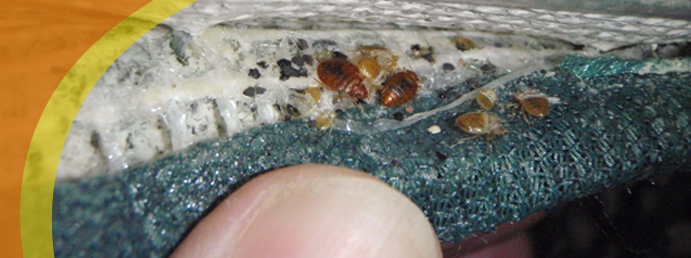Recognizing and Removing Bed Bug Eggs

Bed bugs have been around since the dawn of time, and do not seem to be going away anytime soon. By their very design, they are the perfect non-flying insect for easy transportation, latching onto their unsuspecting victims for a free ride to their new cozy home. Spreading an infestation is easy, being transported from place to place via clothing, luggage, furniture, bedding, and many other means.
There are many ways that you could become the unfortunate victim of a bed bug infestation, and cleanliness is no hindrance for these little bloodsuckers.
Found in the cleanest of hotel rooms, theatres, nursing homes, airports, gyms, and many more places, this small, oval-shaped pest, about the size of a grain of rice, is a survivor of the highest order, living for more than 300 days under it’s preferred and normal conditions. Learning about bed bugs is half the battle, and as you begin to understand their breeding behaviour, you can better get a grip on these pesky pests.
Bed Bugs and Their Eggs
Over a 10-day period, a mated female bed bug will lay around 5 to 20 eggs, laying either in a single, or multiple places. Once she has run out of sperm, she will have to mate again, and this is dependent on her regular feedings. Throughout the course of her lifetime, a female bed bug will produce and lay as many as 131 eggs. Coupled with the 97% successful hatch rate, a real and serious infestation could be imminent. The ratio of male to female bed bug eggs is around 1:1, and under ideal conditions, a bed bug population can double in just 16 days.
Learning about bed bugs teaches us that they will lay their eggs sporadically. Some may lay them all together in the same place, while others may lay them as they move around, leaving every single egg all by itself. Curtains, bedding, mattresses, carpeting, behind loose wallpaper, are all very popular bed bug egg-laying areas.
It has been noted that just a single impregnated female can be responsible for an entire infestation. With the right temperature conditions, along with regular blood feedings, she can produce a colony of bed bugs in no time. She is also able to mate with her own offspring, making her access to sperm unlimited while she is building her empire.
How to Control Bed Bugs and Their Eggs
First and foremost a thorough cleaning of any infected area is in order, rubbing alcohol does a good job of killing bed bugs and their eggs on the spot. To start cleaning an infestation, call the professionals, then remove and wash all your bedding, clothing, linens, and rugs. Wash these items in hot, soapy water, then place them in the dryer on the hottest setting for at least 30 minutes. Once done, shake out all the dead bed bugs from your freshly washed laundry.
Mattresses and rugs should be scrubbed and vacuumed thoroughly. After scrubbing, use your vacuum to remove the dead bugs and their eggs. Dispose of your used vacuum bags in the trash outside of the home. If you have a mattress that has been infested, perhaps it’s best to just get a new one.
Disposing of bed bugs and their eggs is a job that is best left to the professionals, and one that needs due care and diligence to be done effectively and correctly. With Truly Nolen, your bed bug issue is guaranteed to be a thing of the past, never to return and ruin disturb your peace ever again.